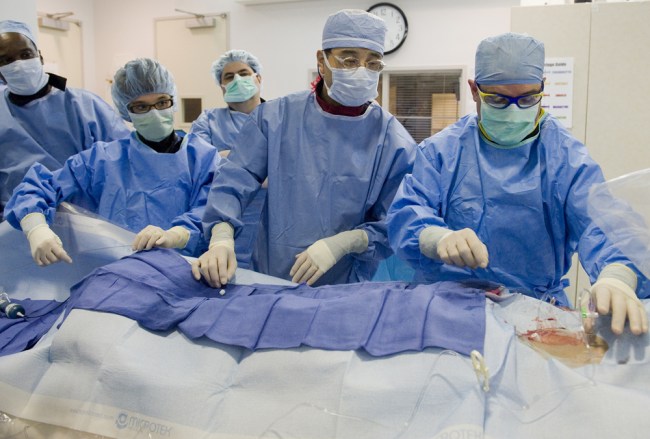
LeAnn Stokes, M.D., left, David Zhao, M.D., Peter Bream, M.D., and colleagues attend to patient Courtney Shumer in the OR. (photo by Joe Howell)
Collaboration drives surgery’s success
Courtney Shumer is 19 years old and would like to have children one day.
It seems like a reasonable goal for someone her age, but Shumer has a rare disorder known as uterine arteriovenous malformation (AVM), a congenital anomaly with only 70-100 cases reported in the scientific literature.
AVM was the cause of a miscarriage that Courtney experienced in December, and if left untreated, will most likely keep her from conceiving again.
AVM is characterized by abnormal blood flow between arteries and veins. With AVM there are no capillaries in between the two vessels so there is no mechanism to slow down the blood flow. Over time, more arteries begin to supply blood to the AVM, causing it to enlarge. As a result, the veins or the abnormal group of blood vessels may rupture and cause a hemorrhage, which is what happened to Shumer after her miscarriage.
Historically, a hysterectomy has been the standard treatment, but given Shumer's age and desire to have children, it was a last resort. LeAnn Stokes, M.D., an interventional radiologist, diagnosed the AVM, and recommended embolization instead.
“We inject very small particles into the uterine artery supplying the AVM. These particles lodge in the abdominal vessels and cause them to close by creating a thrombotic reaction. The embolization should not affect the normal wall of the uterus, allowing the patient to maintain her ability to have a child,” Stokes said.
As a precaution, Stokes performed a cardiac echo on Shumer prior to surgery, which indicated she may have a patent foramen ovale (PFO), or a hole in her heart. Her case quickly became more complicated.
“When you inject particles, some of them can pass directly through the AVM and go back to the heart, which is fine as long as they just go from the heart out to the lungs,” Stokes said.
“But, if you have an abnormal communication within the heart, like a PFO, then the particles can pass directly from the right side of the heart to the left side into the circulatory system to the brain. This could cause stroke and other complications.”
Steve Meranze, M.D., vice-chair of the Department of Radiology and Radiological Sciences, consulted with David Zhao, M.D., director of the Cardiac Catheterization Lab.
“This type of procedure requires extensive experience from both specialties and a collaborative working relationship,” Zhao said. “This result came from a meeting Dr. Meranze and I had where we talked about collaboration. Now we realize what we can do to help each other.”
In a unique arrangement between the two clinical divisions, both Stokes and Zhao scrubbed in on the case. Zhao, who has expertise in closing PFOs, planned to send a balloon catheter via Shumer's femoral vein to temporarily close the hole in her heart before Stokes used a catheter in the femoral artery to transport the particles to close off the AVM.
After a few hours, when the particles were securely in place in the uterus, Zhao could remove the balloon catheter.
“Temporary closure of a PFO is a unique approach. PFOs are usually left open in a person with no other health issues; they don't usually pose a problem,” Zhao said.
Intra-operatively, Zhao discovered that Shumer did not have a PFO, which he confirmed with an intra-cardiac ultrasound, a unique device that interventional cardiologists use to study cardiac abnormalities.
“It was fortunate for Courtney that she did not have a PFO,” Zhao said. “The collaborative approach enabled her to receive the therapy she needed without the potential serious complication.”
Shumer's husband, Robert, who is on active duty with the U.S. military in Iraq, was able to come home for his wife's surgery, which went off without a hitch. She is recovering at home, and he will return to Iraq. They hope to start their family soon.
“I really, really want to have children,” Shumer said. “That's the main reason I had this procedure. We're trying to keep me fertile.”













